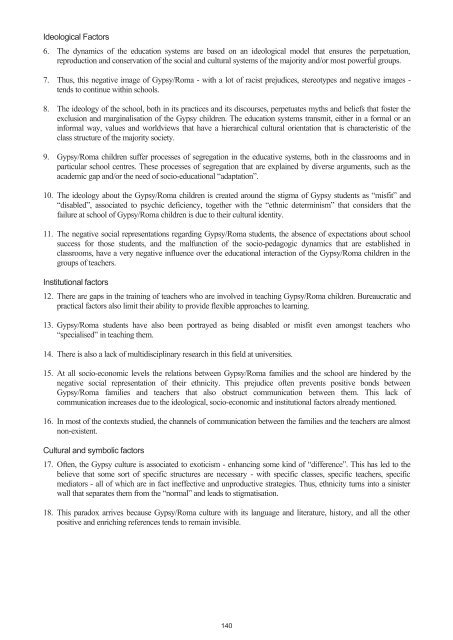briefing papers for policy makers
briefing papers for policy makers
briefing papers for policy makers
Create successful ePaper yourself
Turn your PDF publications into a flip-book with our unique Google optimized e-Paper software.
Ideological Factors<br />
6. The dynamics of the education systems are based on an ideological model that ensures the perpetuation,<br />
reproduction and conservation of the social and cultural systems of the majority and/or most powerful groups.<br />
7. Thus, this negative image of Gypsy/Roma - with a lot of racist prejudices, stereotypes and negative images -<br />
tends to continue within schools.<br />
8. The ideology of the school, both in its practices and its discourses, perpetuates myths and beliefs that foster the<br />
exclusion and marginalisation of the Gypsy children. The education systems transmit, either in a <strong>for</strong>mal or an<br />
in<strong>for</strong>mal way, values and worldviews that have a hierarchical cultural orientation that is characteristic of the<br />
class structure of the majority society.<br />
9. Gypsy/Roma children suffer processes of segregation in the educative systems, both in the classrooms and in<br />
particular school centres. These processes of segregation that are explained by diverse arguments, such as the<br />
academic gap and/or the need of socio-educational “adaptation”.<br />
10. The ideology about the Gypsy/Roma children is created around the stigma of Gypsy students as “misfit” and<br />
“disabled”, associated to psychic deficiency, together with the “ethnic determinism” that considers that the<br />
failure at school of Gypsy/Roma children is due to their cultural identity.<br />
11. The negative social representations regarding Gypsy/Roma students, the absence of expectations about school<br />
success <strong>for</strong> those students, and the malfunction of the socio-pedagogic dynamics that are established in<br />
classrooms, have a very negative influence over the educational interaction of the Gypsy/Roma children in the<br />
groups of teachers.<br />
Institutional factors<br />
12. There are gaps in the training of teachers who are involved in teaching Gypsy/Roma children. Bureaucratic and<br />
practical factors also limit their ability to provide flexible approaches to learning.<br />
13. Gypsy/Roma students have also been portrayed as being disabled or misfit even amongst teachers who<br />
“specialised” in teaching them.<br />
14. There is also a lack of multidisciplinary research in this field at universities.<br />
15. At all socio-economic levels the relations between Gypsy/Roma families and the school are hindered by the<br />
negative social representation of their ethnicity. This prejudice often prevents positive bonds between<br />
Gypsy/Roma families and teachers that also obstruct communication between them. This lack of<br />
communication increases due to the ideological, socio-economic and institutional factors already mentioned.<br />
16. In most of the contexts studied, the channels of communication between the families and the teachers are almost<br />
non-existent.<br />
Cultural and symbolic factors<br />
17. Often, the Gypsy culture is associated to exoticism - enhancing some kind of “difference”. This has led to the<br />
believe that some sort of specific structures are necessary - with specific classes, specific teachers, specific<br />
mediators - all of which are in fact ineffective and unproductive strategies. Thus, ethnicity turns into a sinister<br />
wall that separates them from the “normal” and leads to stigmatisation.<br />
18. This paradox arrives because Gypsy/Roma culture with its language and literature, history, and all the other<br />
positive and enriching references tends to remain invisible.<br />
140


